Related Research Articles

The Austronesian languages are a language family widely spoken throughout Maritime Southeast Asia, parts of Mainland Southeast Asia, Madagascar, the islands of the Pacific Ocean and Taiwan. They are spoken by about 386 million people. This makes it the fifth-largest language family by number of speakers. Major Austronesian languages include Malay, Javanese, Sundanese, Tagalog (Filipino), Malagasy and Cebuano. According to some estimates, the family contains 1,257 languages, which is the second most of any language family.
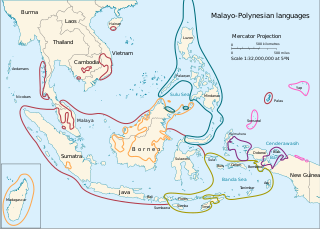
The Malayo-Polynesian languages are a subgroup of the Austronesian languages, with approximately 385.5 million speakers. The Malayo-Polynesian languages are spoken by the Austronesian peoples outside of Taiwan, in the island nations of Southeast Asia and the Pacific Ocean, with a smaller number in continental Asia in the areas near the Malay Peninsula, with Cambodia, Vietnam and the Chinese island Hainan as the northwest geographic outlier. Malagasy, spoken in the island of Madagascar off the eastern coast of Africa in the Indian Ocean, is the furthest western outlier.

North Sulawesi is a province of Indonesia. It is located on the Minahasa Peninsula of the island of Sulawesi, south of the Philippines and southeast of Sabah, Malaysia. It borders the Philippine province of Davao Occidental and Soccsksargen regions of the Philippines to the north, the Maluku Sea to the east, Gorontalo and Celebes Sea to the west and the Gulf of Tomini to the southwest. With the outlying island of Miangas to its north, it is the northernmost island of Indonesia. The province's area is 14,500.28 square kilometres (5,598.59 sq mi), and its population was 2,270,596 according to the 2010 census; this rose to 2,621,923 at the 2020 Census, while the official estimate as at mid 2022 was 2,659,543. North Sulawesi is known as a heaven for divers around the world.

The Minahasans or Minahassa are an indigenous ethnic group from the North Sulawesi province of Indonesia, formerly known as North Celebes. The Minahasa people sometimes refer to themselves as Manado people. Although the Minahasan pre-Christian creation myth entails some form of ethnic unification, before the nineteenth century the Minahasa region was in no way unified. Instead, a number of politically independent groups (walak) existed together, often in a permanent state of conflict.

The Philippine languages or Philippinic are a proposed group by R. David Paul Zorc (1986) and Robert Blust that include all the languages of the Philippines and northern Sulawesi, Indonesia—except Sama–Bajaw and a few languages of Palawan—and form a subfamily of Austronesian languages. Although the Philippines is near the center of Austronesian expansion from Formosa, there is little linguistic diversity among the approximately 150 Philippine languages, suggesting that earlier diversity has been erased by the spread of the ancestor of the modern Philippine languages.
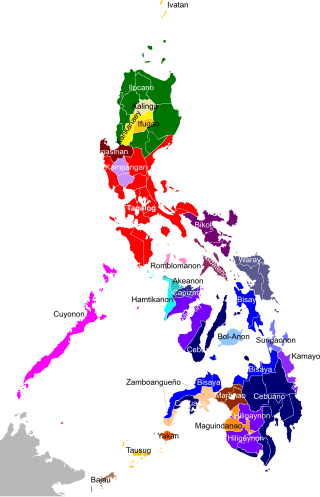
The Philippines is inhabited by more than 182 ethnolinguistic groups, many of which are classified as "Indigenous Peoples" under the country's Indigenous Peoples' Rights Act of 1997. Traditionally-Muslim peoples from the southernmost island group of Mindanao are usually categorized together as Moro peoples, whether they are classified as Indigenous peoples or not. About 142 are classified as non-Muslim Indigenous People groups, and about 19 ethnolinguistic groups are classified as neither indigenous nor moro. Various migrant groups have also had a significant presence throughout the country's history.

The Sangihe Islands – Indonesian: Kepulauan Sangihe – are a group of islands which constitute two regencies within the province of North Sulawesi, in northern Indonesia, the Sangihe Islands Regency and the Sitaro Islands Regency. They are located north-east of Sulawesi between the Celebes Sea and the Molucca Sea, roughly halfway between Sulawesi and Mindanao, in the Philippines; the Sangihes form the eastern limit of the Celebes Sea. The islands combine to total 813 square kilometers (314 sq mi), with many of the islands being actively volcanic with fertile soil and mountains.
Sangirese, also known as Sangihé, Sangi, and Sangih, is an Austronesian language spoken on the islands linking northern Sulawesi, Indonesia, with Mindanao, Philippines by the Sangirese people.
The Minahasan languages are a subgroup of the Austronesian languages spoken by the Minahasa people in northern Sulawesi, Indonesia. They belong to the Philippine subgroup.
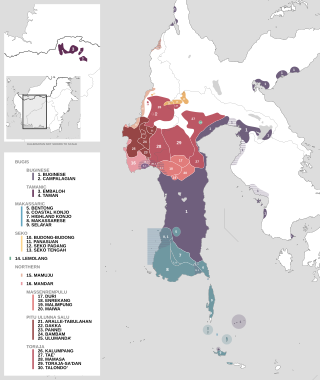
The South Sulawesi languages are a subgroup of the Austronesian language family. They are primarily spoken in the Indonesian provinces of South Sulawesi and West Sulawesi, with a small outlying pocket in West Kalimantan.
The Celebic languages are a subgroup of the Austronesian languages spoken on the Indonesian island of Sulawesi, formerly called Celebes. Almost all of the languages spoken in the provinces of Central Sulawesi and Southeast Sulawesi belong to the Celebic group. A few Celebic languages are located in South Sulawesi province. By number of languages, Celebic is the largest subgroup of Austronesian languages on Sulawesi.
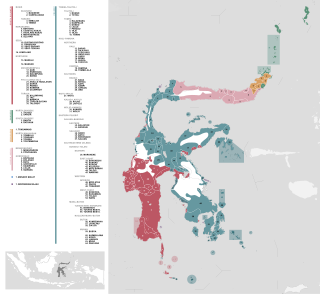
On the Indonesian island of Sulawesi, 114 native languages are spoken, all of which belong to the Malayo-Polynesian subgroup of the Austronesian language family. With a total number of 17,200,000 inhabitants, Sulawesi displays a high linguistic diversity when compared with the most densely populated Indonesian island Java, which hosts 4–8 languages spoken by 145,100,000 inhabitants.
The Greater Central Philippine languages are a proposed subgroup of the Austronesian language family, defined by the change of Proto-Malayo-Polynesian *R to *g. They are spoken in the central and southern parts of the Philippines, and in northern Sulawesi, Indonesia. This subgroup was first proposed by Robert Blust (1991) based on lexical and phonological evidence, and is accepted by most specialists in the field.
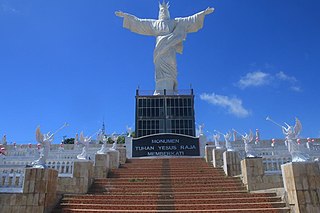
The Talaud Islands Regency is a regency of North Sulawesi province, Indonesia. The Talaud Islands form an archipelago situated to the north-east of the Minahasa Peninsula, with a land area of 1,251.02 km2. It had a population of 83,434 at the 2010 Census, increasing to 94,521 at the 2020 Census; the official estimate as at mid 2022 was 95,545. The largest island is Karakelong, on which lies the regency seat in the town of Melonguane. To its south lie the islands of Salibabu and Kabaruan, while the Nanusa group of 7 small islands lies to the northeast of Karakelong, and Miangas island is situated midway between Karakelong and the Philippines. It is one of the three regencies to the north of North Sulawesi that are located between Sulawesi and the Philippines, along with the Sitaro Islands Regency and Sangihe Islands Regency; originally these formed a single regency, but on 110 April 2002 the Talaud Islands were split off to form their own Regency. The island of Miangas is the most northerly island in the regency and widely regarded as the northernmost point of Indonesia. As the result, it is often referenced to describe the territorial integrity of Indonesia in various patriotic statements and songs together with Sabang, Merauke, and Rote Island.
Bambam is an Austronesian language of West Sulawesi, Indonesia. It is spoken in the Mambi and Tabang districts of Mamasa Regency, and in the Matangnga district of Polewali Mandar Regency. Together with Aralle-Tabulahan, Ulumanda', Pannei and Dakka, Bambam belongs to the Pitu Ulunna Salu languages, which form a subbranch within the Northern branch of the South Sulawesi subgroup.
Coastal Konjo is an Austronesian language of Sulawesi, Indonesia, which belongs to the Makassaric branch of the South Sulawesi subgroup. It is spoken along the coast in the southeastern corner of South Sulawesi in the regencies of Sinjai, Bulukumba and Bantaeng. It is closely related to, but distinct from Highland Konjo, which also belongs to the Makassaric languages.
Tonsawang, also known as Tombatu, is an Austronesian language of the northern tip of Sulawesi, Indonesia. It belongs to the Minahasan branch of the Philippine languages.
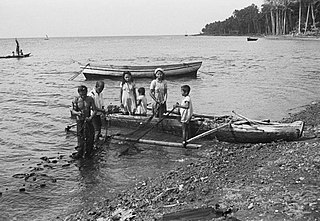
Sangirese or Sangihe people are one of the native people to the Sangir Islands in the northern chain of islands in Sulawesi and the southern part of Mindanao. The Sangirese people are fishermen and nutmeg growers in their home areas and also work as wage labourers in industrial crops enterprises in Bolaang Mongondow Regency and Minahasa Regency.
The Seko languages are a group of four closely related Austronesian languages spoken in West Sulawesi and South Sulawesi provinces, Indonesia. They make up a primary branch of the South Sulawesi subgroup. The languages of the Seko branch are: Seko Padang, Seko Tengah, Panasuan and Budong-Budong.
The Proto-Philippine language is a reconstructed ancestral proto-language of the Philippine languages, a proposed subgroup of the Austronesian languages which includes all languages within the Philippines as well as those within the northern portions of Sulawesi in Indonesia. Proto-Philippine is not directly attested to in any written work, but linguistic reconstruction by the comparative method has found regular similarities among languages that cannot be explained by coincidence or word-borrowing.
References
- ↑ Adelaar, K. Alexander; Himmelmann, Nikolaus (2005). The Austronesian languages of Asia and Madagascar. London: Routledge.
- 1 2 Sneddon, James N. (1984). "Proto-Sangiric and the Sangiric languages". Pacific Linguistics. Canberra. doi: 10.15144/PL-B91 .